
Welcome to SSDBM 2019
[Conference Organizers] [Program - Proceedings - Keynotes - Detailed Agenda - Social Events] [Information for Participants - Registration - Accommodation - Venue - Directions] [Sponsorship]
The 31st International Conference on Scientific and Statistical Database Management will be held in Santa Cruz, CA, USA on July 23-25, 2019. The SSDBM international conference brings together scientific domain experts, database researchers, practitioners, and developers for the presentation and exchange of current research results on concepts, tools, and techniques for scientific and statistical database applications. The 31st SSDBM will provide a forum for original research contributions and practical system design, implementation and evaluation, and, for the first time, reproducibility studies of previous publications. The program of the research track will be supplemented with invited talks and demonstrations. SSDBM 2019 will continue the tradition of past SSDBM meetings in providing a stimulating environment to encourage discussion, fellowship and exchange of ideas in all aspects of research related to scientific and statistical data management.
Tanu Malik (Program Chair)
Ivo Jimenez (Reproducibility Chair)
Carlos Maltzahn (General Chair)
We thank our sponsors
Local organizers
Conference Organizers
Chairs
General: Carlos Maltzahn, University of California, Santa Cruz - Program: Tanu Malik, DePaul University, Chicago - Reproducibility: Ivo Jimenez, University of California, Santa Cruz - Local Arrangements: Lavinia Preston and Stephanie Lieggi, University of California, Santa Cruz - Proceedings: Tanu Malik - Web: Ivo Jimenez
To contact any of the chairs, please use ssdbm19@easychair.org.
Steering Committee
Arie Shoshani, Lawrence Berkeley National Laboratory (chair)
Torben Bach Pedersen, Aalborg University
Magdalena Balazinska, University of Washington
Amarnath Gupta, University of California San Diego
Ioana Manolescu, Inria-Paris
Program Committee
Gagan Agrawal, Ohio State University
Peter Baumann, Jacobs University, Bremen
Khalid Bellhajahme, University Paris-Dauphine
Souvik Bhattacharjee, University of Maryland, College Park
Tamas Budavari, Johns Hopkins University
Amit Chavan, Amazon Web Services
Lazlo Doblos, Eötvös Loránd University, Budapest
Shawfeng Dong, SLAC National Accelerator Laboratory
Ahmed Eldawy, University of California, Riverside
Thomas Heinis, Imperial College, UK
Ashish Gehani, SRI International
Boris Glavic, Illinois Institute of Technology, Chicago
Pascal Grosset, Los Alamos National Laboratory
Ian Foster, University of Chicago, Chicago
Verena Kantere, University of Ottawa, Ontario
Jeff LeFevre, University of California, Santa Cruz
Ulf Leser, Humboldt-Universität zu Berlin
Qing Gary Liu, New Jersey Institute of Technology
Marjan Mernik, University of Maribor
Hui Miao, University of College Park, Maryland
Paolo Missier, Newcastle University
Beth Plale, Indiana University, Bloomington
Neoklis Polyzotis, Google, Inc.
Dave Pugmire, Oakridge National Laboratory
Maya Ramanath, Indian Institute of Technology, Delhi
Alexander Rasin, DePaul University, Chicago
Tore Risch, Uppsala University
Florin Rusu, University of California, Merced
Iulian Sandu-Popa, University of Versailles Saint-Quentin and INRIA
Galen Shipman, Los Alamos National Laboratory
Douglas Thain, University of Notre Dame
Srikanta Tirthapura, Iowa State University
Yicheng Tu, University of South Florida, Tampa
Jon Woodring, Los Alamos National Laboratory
K. John Wu, Lawrence Berkeley National Laboratory
Hongfeng Yu, University of Nebraska, Lincoln
Xuechen Zhang, Washington State University
Ming Zhao, Arizona State University, Phoenix
Qiang Zhu, University of Michigan, Dearborn
Call for Contributions
The SSDBM international conference brings together scientific domain experts, database researchers, practitioners, and developers for the presentation and exchange of current research results on concepts, tools, and techniques for scientific and statistical databases and applications. The 31st SSDBM provides a forum for original research contributions and practical system designs, implementations and evaluations. The program of the research track will be supplemented with invited talks and demonstrations.
SSDBM 2019 will continue the tradition of past SSDBM meetings in providing a stimulating environment to encourage discussion and exchange of ideas on all aspects of research related to scientific and statistical data management.
 All accepted papers will be published by ACM – International Conference Proceedings Series (ICPS) and will be available in the ACM Digital Library.
All accepted papers will be published by ACM – International Conference Proceedings Series (ICPS) and will be available in the ACM Digital Library.
Topics of Interest
SSDBM 2019 will have a focus on high-performance data analysis tools and techniques for large data sets, with a special emphasis on genomics, astrophysics, and high-energy physics. The conference encourages authors to make their experimental results reproducible and include reproducibility experiences in their submissions .
Topics of particular interest include, but are not limited to, the following, as they relate to scientific and statistical data management:
- System architectures for scientific and statistical data management and analysis
- Querying of scientific data, including spatial, temporal, and streaming data
- Mining and analysis of large-scale datasets, especially on new and emerging hardware and environments
- Data flow management in high performance computing
- Techniques for comparing simulation and experimental data
- Cloud computing issues in large-scale data management
- Provenance data management
- Design, implementation, optimization, and reproducibility of scientific workflows
- Integration and exchange of data, including the federation and management of institutional data repositories
- Visualization and exploration of large datasets
- Information retrieval and text mining
- Knowledge discovery, clustering, graph analysis
- Case studies, particularly those at scale-of-consequence for genomics, astrophysics, and high-energy physics
- Stream data management, e.g., storage, organization, compression, indexing and querying
- Stream data analysis, e.g., summarization, statistical analysis, pattern matching, pattern discovery, learning, and prediction
- Modeling and representation of streaming data
Submission guidelines
We solicit papers describing original work relevant to the management of scientific and statistical data and not published or under review elsewhere. SSDBM 2019 is single-blind reviewed. Therefore, authors must include their names and affiliations on the first page. SSDBM submissions can be research, reproducibility study, or demo papers (all page limits including everything):
Research Papers (LONG and SHORT): We solicit both full papers (12 pages) and short papers (4 pages). The former tend to be descriptions of complete technical work, while the latter tend to be descriptions of interesting, innovative ideas, which nevertheless require more work to mature. The program committee may decide to accept some full papers as short papers. Full papers will be given a presentation slot in the conference, while short papers will be presented in the form of posters. All papers, regardless of size, will be given an entry in the conference proceedings. Authors may optionally include reproducibility information that allows for automated validation of experimental results (see artifact evaluation criteria). Accepted submissions passing automated validation will earn a prestigious “Results Replicated” Badge in the ACM DL in accordance with ACM’s artifact review and badging policy.
New! Reproducibility Study Papers: We also call for reproducibility studies (12 pages) that for the first time reproduce experiments from papers previously published in SSDBM or in other peer-reviewed conferences with similar topics of interest (see reproducibility study instructions). Reproducibility study submissions are selected by the same peer-reviewed competitive process as regular research papers, except these submissions must pass automated validation of experimental results (see artifact evaluation criteria). Accepted submissions passing automated validation will earn the prestigious ACM “Results Replicated” Badge and, if the work under study was successfully reproduced, the associated paper will earn the ACM “Results Reproduced” Badge in the ACM DL in accordance with ACM’s artifact review and badging policy.
Demo Papers: We solicit demonstration proposals (4 pages) which should provide the motivation for the demonstrated concepts, the information about the technology and the system to be demonstrated (including a system description, functionality and figures when applicable), and should state the significance of the contribution. Selection criteria for the demonstration proposals evaluation include: the novelty, the technical advances and challenges, and the overall practical attractiveness of the demonstrated system. Demo papers will also be given an entry in the conference proceedings.
The submission website is https://easychair.org/conferences/?conf=ssdbm19. Submissions are accepted in PDF format using the new ACM proceedings LATEX or Word templates. Authors should use the sigconf proceedings template. Please see instructions at the ACM web site: http://www.acm.org/publications/article-templates/proceedings-template.html. If you are encountering any problems using the LATEX templates, please contact acmtexsupport@aptaracorp.com. For all other questions, please contact ssdbm19@easychair.org.
Important dates
The following deadlines apply to long, short, reproducibility study, and demo papers:
Paper submission: March 4 March 11, 2019, 11:59pm AOE (Anywhere on Earth)
Notification of acceptance: April 26 May 3, 2019
Camera ready copy: June 3, 2019
Camera-ready Instructions
 All accepted papers will be published by ACM – International Conference Proceedings Series (ICPS) and will be available in the ACM Digital Library.
All accepted papers will be published by ACM – International Conference Proceedings Series (ICPS) and will be available in the ACM Digital Library.
IMPORTANT: ACM now requires conference organizers to collect and submit the source files for each paper – all files which were used to create the final output (PDF), be they Word, LaTeX, image files, etc. Submission of source files was always a requirement, albeit one that was hardly enforced in the past. In anticipation of serving both accessibility compliant PDF and responsive HTML5 formatted files from the ACM Digital Library, ACM is now enforcing this requirement.
The deadline for submitting the camera-ready paper is June 3rd. This is a hard deadline; late submissions will not be included in the proceedings. To prepare the camera-ready version, please follow these steps:
ACM now requires conference organizers to collect and submit the source files for each paper – all files which were used to create the final output (PDF), be they Word, LaTeX, image files, etc. Submission of source files was always a requirement, albeit one that was hardly enforced in the past. In anticipation of serving both accessibility compliant PDF and responsive HTML5 formatted files from the ACM Digital Library, ACM is now enforcing this requirement.
- Authors who are specified in EasyChair as contacts must have received an email from ACM Rightsreview (rightsreview@acm.org) with a link to the electronic ACM copyright-permission form. Please complete the form as soon as possible. IMPORTANT: the email is sent by an automated system to the primary contact only. Please make sure that the authors specified as contacts have received the email and that it has not wound up in a Spam folder.
- Upon completion of the ACM rights management form, the authors will receive an email with instructions on how to include rights and permissions information, and the bibliographic strip into the camera-ready version. Your must enter the text into their paper. Please follow the instructions carefully.
- Ensure that your camera-ready version complies with the ACM Master Template. Instructions are available at https://www.acm.org/publications/proceedings-template. You should use the “sigconf” proceedings template. If you have any problems with the templates, please contact ACM’s TeX support team at Aptara (acmtexsupport@aptaracorp.com).
- Use the online CCS indexing tool (http://dl.acm.org/ccs/ccs.cfm?) to select appropriate CCS concepts for your article. Then, generate the corresponding text/code and include it into your camera-ready version.
- Create the camera-ready PDF, paying attention to the following:
- Adhere to the page limits: 12 pages for full and reproducibility study papers, 4 pages for short and demo papers.
- Page size should be US-Letter 8.5in x 11in (around 21.59cm x 27.94cm).
- All fonts must be Type 1 (scalable), and not Type 3 (bit-mapped). All fonts must be embedded within the PDF file. See instructions here: http://www.ec.tuwien.ac.at/~dimitris/var/fonts.html.
- Do not include page numbers.
- Submit the camera-ready PDF in EasyChair (https://easychair.org/conferences/?conf=ssdbm19). In addition to the camera-ready PDF, you must also submit an archive (zip or tgz) with the source files (LaTeX or Word).
For any questions regarding your camera-ready version, please contact ssdbm19@easychair.org.
Program
Proceedings
Proceedings are availabe at the ACM Digital Library: https://dl.acm.org/citation.cfm?id=3335783
Accepted Papers
Mining and Data Analysis
- Lacramioara Mazilu, Norman Paton, Alvaro Fernandes and Martin Koehler. Dynamap Schema Mapping Generation in the Wild
- Uday Kiran. Discovering Spatial High Utility Itemsets in Spatiotemporal Datasets
- Sebastian Schelter, Ufuk Celebi and Ted Dunning. Efficient Incremental Cooccurrence Analysis for Item-Based Collaborative Filtering
Statistical Data Analysis
- Vadim Arzamasov, Klemens Boehm and Ignaz Rutter. Minimizing Bias in Estimation of Mututal Information from Data Streams
- Edouard Fouché and Klemens Böhm. Monte Carlo Dependency Estimation (Best Paper)
- Luan Tran, Liyue Fan and Cyrus Shahabi. Outlier Detection in Non-stationary Data Streams
Data Summarization
- Ioannis Mytilinis, Dimitrios Tsoumakos and Nectarios Koziris. Maintaining Wavelet Synopses for Sliding Window Aggregates (Best Paper Runner Up).
- Jinho Lee and Frank Liu. An Efficient Graph Compressor Based on Adaptive Prefix Encoding
- Michael Vollmer, Lukasz Golab, Klemens Böhm and Divesh Srivastava. Informative Summarization of Numeric Data
Custom Querying
- Vahid Ghadakchi, Abtin Khodadadi and Arash Termehchy. Less Data Delivers Higher Search Effectiveness for Keyword Queries
- Jochem Kuijpers, George H. L. Fletcher, Tobias Lindaaker and Nikolay Yakovets. An Experimental Study of Context-Free Path Query Evaluation Methods
- Joseph Vinish Dsilva, Florestan De Moor and Bettina Kemme. Keep Your Host Language Object and Also Query it: A Case for SQL Query Support in RDBMS for Host Language Objects
Space and time support in database systems
- Haoyuan Xing and Gagan Agrawal. Accelerated Array Joining with integrated index value
- Robert Schuler and Carl Kesselman. A High-level User-oriented Framework for Database Evolution
- Maximilian Schüle, Lukas Karnowski, Josef Schmeißer, Benedikt Kleiner, Alfons Kemper and Thomas Neumann. Versioning in Main-Memory Database Systems: From MusauesDB to TardisDB
Short Papers
- Anna Beer, Daniyal Kazempour, Lisa Stephan and Thomas Seidl. LUCK- Linear Correlation Clustering Using Cluster Algorithms and a kNN based Distance Function
- Anna Beer and Thomas Seidl. Graph Ordering and Clustering - A Circular Approach
- Chris Michael, Joseph Macker and Frederick Petry. Towards Generalizing Stochastic Spatiotemporal Graphs for Analyzing Least-Cost Path Stability
- Mohammad Mahdavi and Ziawasch Abedjan. REDS: Estimating the Performance of Error Detection Strategies Based on Dirtiness Profiles
- Rasaq Otunba. Deep Stacked Ensemble Recommender
- Bin Dong, Patrick Frank Heiner Kilian, Xiaocan Li, Fan Guo, Suren Byna and Kesheng Wu. Terabyte-scale Particle Data Analysis: An ArrayUDF Case Study
- Jianjun Liu, Zainab Zolaktaf and Rachel Pottinger. Improvement of SQL Recommendation on Scientific Database
- Glenn Galvizo and Lipyeow Lim. An Experimental Survey of Evaluation Strategies for Constellation Queries
- Jinghan Meng, Yi-Cheng Tu and Napath Pitaksirianan. Generalizing Design of Support Measures for Counting Frequent Patterns in Graphs
- Akshay Kansal and Francesca Spezzano. SQUID: A Scalable System for Querying, Updating and Indexing Dynamic Graph Databases
- Daniyal Kazempour and Thomas Seidl. On systematic hyperparameter analysis through the example of subspace clustering
- Daniyal Kazempour, Kilian Emmerig, Peer Kröger and Thomas Seidl. Detecting Global Periodic Correlated Clusters in Event Series based on Parameter Space Transform
Keynotes
Magdalena Balazinska (University of Washington)
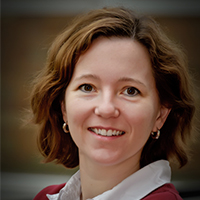
Title: The LightDB Video Database Management System
Abstract: Video data management has recently re-emerged as an active research area due to advances in machine learning and graphics hardware, as well as the emergence of applications such as adaptive streaming, object detection, and virtual reality. In this talk, we start with a review of the key requirements of modern video data management and analytics applications. We then present Visual Road, a new benchmark that we developed to assess video database systems on the needs of those modern applications. Finally, we dive into the details of LightDB, a new system that we are building at the University of Washington for the storage, retrieval, and analysis of video databases, including overlapping videos and 360-degree videos.
Bio: Magdalena Balazinska is a Professor in the Paul G. Allen School of Computer Science and Engineering at the University of Washington and the Director of the University of Washington data science institute called eScience. She is also the Associate Vice Provost for Data Science and the director of the Advanced Data Science PhD Option. Magdalena’s research interests are in the field of database management systems. Her current research focuses on data management for data science, big data systems, cloud computing, and image and video analytics (including data management for VR/AR). Magdalena holds a Ph.D. from the Massachusetts Institute of Technology (2006). She is a Microsoft Research New Faculty Fellow (2007), received the inaugural VLDB Women in Database Research Award (2016), an ACM SIGMOD Test-ofTime Award (2017), an NSF CAREER Award (2009), a 10-year most influential paper award (2010), two Google Research Awards (2011 and 2018), an HP Labs Research Innovation Award (2009 and 2010), a Rogel Faculty Support Award (2006), a Microsoft Research Graduate Fellowship (2003-2005), and multiple best-paper awards.
Susan Davidson (University of Pennsylvania)
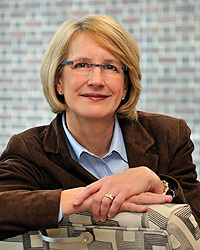
Title: Publication in the Era of Big Data Science
Abstract: Scientific research results are increasingly being published in online datasets and in code repositories. Since the future of open science is driven by people being willing to share such information, this raises the question of how these new research products should be cited so that their creators can be given appropriate credit. Although this is well understood in the context of conventional publications (e.g. books and articles), principles and standards for data and software citation are only just emerging. However, these important standards are unlikely to be used unless the process of extracting information/code is coupled with that of providing a citation for it. In this talk, I will focus initially on complex, structured, evolving datasets, and will discuss how to automatically generate citations to data extracted by a query. I will then discuss automating citation of open-source software in Git-based platforms.
Bio: Dr. Susan Davidson is Weiss Professor of Computer and Information Science at the University of Pennsylvania. Her recent leadership roles and awards include Chair, Board of Directors, CRA; Chair, CIS; Member, CCC; Member, VLDB Endowment Board; Deputy Dean, SEAS; co-Founder, Greater Philadelphia Bioinformatics Alliance (GPBA); Founding co-Director, Center for Bioinformatics; Fulbright Scholar and Hitachi Chair, INRIA-GEMO. Her research interests are in Databases, including data models and languages, complex object systems, semistructured data and XML, database transformations, data integration, data warehousing, transactions and updates, constraints, data cleaning, data reconciliation, data citation, and Bioinformatics, including biomedical databases, workflow systems, and data provenance. Prof. Susan Davidson holds a Ph.D. in Computer Science from Princeton University (1982).
Alok Choudhary (Northwestern University)
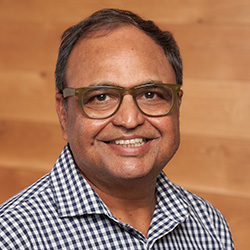
Title: Accelerating Discoveries and Designs with Data Science and Machine Learning
Abstract: Modern instruments, supercomputing simulations, experiments, sensors and IoT are creating massive amounts of data at an astonishing speed and diversity. This has the potential to transform speed of discovery, thereby accelerating the pace of innovation in materials, medicine to marketing and many disciplines in between. This talk will illustrate how HPC, data science and ML collectively can accelerate discoveries in these and other disciplines.
Bio: Alok Choudhary is the Henry & Isabelle Dever Professor of Electrical Engineering and Computer Science and a professor at Kellogg School of Management. He is also the founder, chairman and chief scientist (served as its CEO during 2011-2013) of 4C insights (formerly Voxsup Inc.), a big data analytics and marketing technology software company. He received the National Science Foundation’s Young Investigator Award in 1993. He is a fellow of IEEE, ACM and AAAS. His research interests are in high-performance computing, data intensive computing, scalable data mining, high-performance I/O systems, software and their applications in science, medicine and business. Alok Choudhary has published more than 400 papers in various journals and conferences and has graduated 40+ PhD students. Alok Choudhary’s work and interviews have appeared in many traditional media including New York Times, Chicago Tribune, The Telegraph, ABC, PBS, NPR, AdExchanger, Business Daily and many international media outlets all over the world. He holds a Ph.D. in Computer Engineering from the University of Illinois, Urbana-Champaign.
Program Overview
Tuesday, July 23
| 7:45-8:30 | Registration & Breakfast (45 mins) |
| 8:30-10:00 | Welcome & Keynote Address: Magdalena Balazinska (University of Washington): The LightDB Video Database Management System (90 mins) |
| 10:00-10:30 | Morning Break (30 mins) |
| 10:30-11:45 | Statistical Data Analysis (75 mins) |
| 11:45-1:00 | Lunch Break (75 mins) |
| 1:00-2:15 | Space and time support in database systems (75 mins) |
| 2:15-2:45 | Afternoon Break (30 mins) |
| 2:45-3:55 | Short Paper Presentations (5 mins each) |
| 4:30-5:00 | Shuttle service to UCSC Hay Barn |
| 5:00-7:00 | Reception at the UCSC Hay Barn |
| 7:00-7:30 | Shuttle service back to Core West Parking |
Wednesday, July 24
| 8:45-9:30 | Registration & Breakfast (45 mins) |
| 9:30-10:45 | Welcome & Keynote Address: Susan Davidson (University of Pennsylvania): Publication in the Era of Big Data Science (75 mins) |
| 10:45-11:15 | Morning Break (30 mins) |
| 11:15-12:30 | Data Summarization (75 mins) |
| 12:30-1:45 | Lunch Break (75 mins) and Poster Session? |
| 1:45-3:00 | Custom Querying (75 mins) |
| 3:00-4:15 | Poster Session (75 mins) |
| 5:00-5:30 | Shuttle service to UCSC Seymour Center |
| 5:30-6:30 | Appetizers/drinks at Seymour Center Exhibit Hall and Shipwreck Deck |
| 6:30-9:00 | Banquet at the UCSC Seymour Center, La Feliz Room |
| 9:00-9:30 | Shuttle service back to Core West Parking |
Thursday, July 25
| 8:45-9:20 | Breakfast (35 mins) |
| 9:20-10:30 | Opening Remarks & Keynote Address: Alok Choudhary (Northwestern University): Accelerating Discoveries and Designs with Data Science and Machine Learning (70 mins) |
| 10:30-10:50 | Morning Break (20 mins) |
| 10:50-12:05 | Mining and Data Analysis (75 mins) |
| 12:05-1:20 | Lunch Break (75 mins) |
Detailed Program
Tuesday, July 23
| 7:45-8:30 | Registration & Breakfast (45 mins) |
| 8:30-10:00 | Welcome & Keynote Address: Magdalena Balazinska (University of Washington): The LightDB Video Database Management System (90 mins) |
| 10:00-10:30 | Morning Break (30 mins) |
| 10:30-11:45 | Statistical Data Analysis (75 mins) |
| Vadim Arzamasov, Klemens Boehm and Ignaz Rutter. Minimizing Bias in Estimation of Mututal Information from Data Streams | |
| Edouard Fouché and Klemens Böhm. Monte Carlo Dependency Estimation (Best Paper) | |
| Luan Tran, Liyue Fan and Cyrus Shahabi. Outlier Detection in Non-stationary Data Streams | |
| 11:45-1:00 | Lunch Break (75 mins) |
| 1:00-2:15 | Space and time support in database systems (75 mins) |
| Haoyuan Xing and Gagan Agrawal. Accelerated Array Joining with integrated index value | |
| Robert Schuler and Carl Kesselman. A High-level User-oriented Framework for Database Evolution | |
| Maximilian Schüle, Lukas Karnowski, Josef Schmeißer, Benedikt Kleiner, Alfons Kemper and Thomas Neumann. Versioning in Main-Memory Database Systems: From MusauesDB to TardisDB | |
| 2:15-2:45 | Afternoon Break (30 mins) |
| 2:45-3:55 | Short Paper Presentations (5 mins each) |
| See accepted short papers. | |
| 4:30-5:00 | Shuttle service to UCSC Hay Barn |
| 5:00-7:00 | Reception at the UCSC Hay Barn |
| 7:00-7:30 | Shuttle service back to Core West Parking |
Wednesday, July 24
| 8:45-9:30 | Registration & Breakfast (45 mins) |
| 9:30-10:45 | Welcome & Keynote Address: Susan Davidson (University of Pennsylvania): Publication in the Era of Big Data Science (75 mins) |
| 10:45-11:15 | Morning Break (30 mins) |
| 11:15-12:30 | Data Summarization (75 mins) |
| Ioannis Mytilinis, Dimitrios Tsoumakos and Nectarios Koziris. Maintaining Wavelet Synopses for Sliding Window Aggregates (Best Paper Runner Up). | |
| Jinho Lee and Frank Liu. An Efficient Graph Compressor Based on Adaptive Prefix Encoding | |
| Michael Vollmer, Lukasz Golab, Klemens Böhm and Divesh Srivastava. Informative Summarization of Numeric Data | |
| 12:30-1:45 | Lunch Break (75 mins) |
| 1:45-3:00 | Custom Querying (75 mins) |
| Vahid Ghadakchi, Abtin Khodadadi and Arash Termehchy. Less Data Delivers Higher Search Effectiveness for Keyword Queries | |
| Jochem Kuijpers, George H. L. Fletcher, Tobias Lindaaker and Nikolay Yakovets. An Experimental Study of Context-Free Path Query Evaluation Methods | |
| Joseph Vinish Dsilva, Florestan De Moor and Bettina Kemme. Keep Your Host Language Object and Also Query it: A Case for SQL Query Support in RDBMS for Host Language Objects | |
| 3:00-4:15 | Poster Session |
| All papers. | |
| 5:00-5:30 | Shuttle service to UCSC Seymour Center |
| 5:30-6:30 | Appetizers/drinks at Seymour Center Exhibit Hall and Shipwreck Deck |
| 6:30-9:00 | Banquet at the UCSC Seymour Center, La Feliz Room |
| 9:00-9:30 | Shuttle service back to Core West Parking |
Thursday, July 25
| 8:45-9:20 | Breakfast (35 mins) |
| 9:20-10:30 | Opening Remarks & Keynote Address: Alok Choudhary (Northwestern University): Accelerating Discoveries and Designs with Data Science and Machine Learning (70 mins) |
| 10:30-10:50 | Morning Break (20 mins) |
| 10:50-12:05 | Mining and Data Analysis (75 mins) |
| Lacramioara Mazilu, Norman Paton, Alvaro Fernandes and Martin Koehler. Dynamap Schema Mapping Generation in the Wild | |
| Uday Kiran. Discovering Spatial High Utility Itemsets in Spatiotemporal Datasets | |
| Sebastian Schelter, Ufuk Celebi and Ted Dunning. Efficient Incremental Cooccurrence Analysis for Item-Based Collaborative Filtering | |
| 12:05-1:20 | Lunch Break (75 mins) |
Social Events
July 23, 5:00-7:00pm – Reception at the historic Cowell Hay Barn on the UCSC Campus
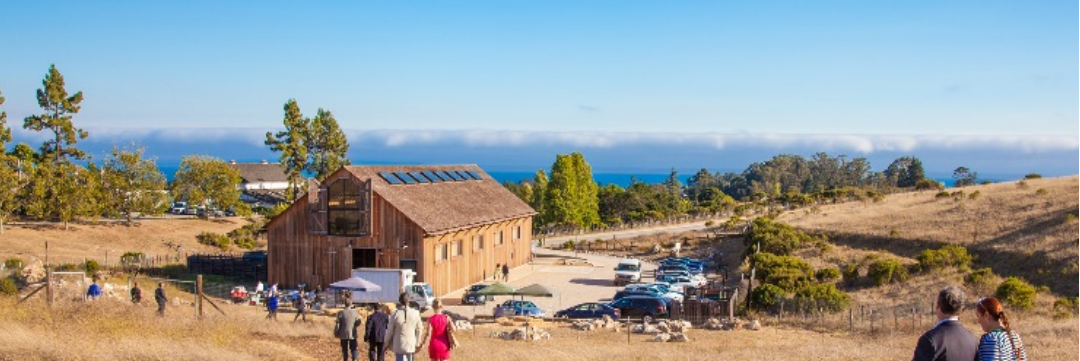
The original Cowell Ranch Hay Barn was built in the early 1860s as part of the Cowell Lime Works operation. The Hay Barn was an integral part of the Cowell Ranch, housing feed and the animals that hauled logs, limestone, and finished lime. Today the Hay Barn and the many nearby historic structures from the lime works period are part of the Cowell Lime Works Historic District.
The original Hay Barn was completely disassembled and renovated in 2015 to serve as a space for public use and headquarters of the Center for Agroecology & Sustainable Food Systems.
The reconstructed Hay Barn incorporates some of the historic barn’s heavy timbers and siding, and features traditional mortise-and-tenon framing juxtaposed with modern materials and contemporary design, to achieve a rustic yet visually distinct building. The award-winning result is a beautiful and dramatic signature building with a soaring, spacious interior offering a unique setting for weddings, banquets, concerts, conferences, and much more. See https://cowellhaybarn.ucsc.edu/ for more information about the Hay Barn and its history.
July 24, 5:30-9:00pm – Reception & Banquet at the Seymour Marine Discovery Center
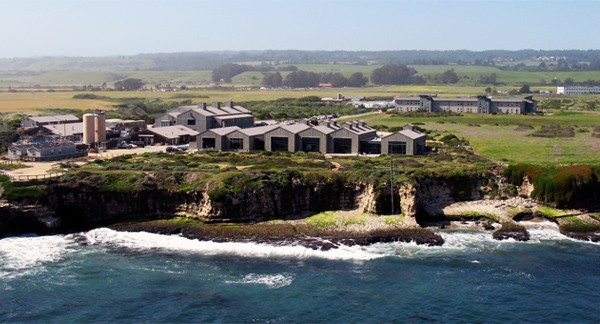
The Seymour Marine Discovery Center is a community-supported marine science education center of the University of California, Santa Cruz. It resides on the UC Santa Cruz Coastal Science Campus, a dynamic hub for research, education, and policy programs that address coastal and ocean conservation and management issues. Here, some of the world’s best coastal and marine scientists, government and non-government experts, and public education leaders create synergies that result in discovery and effective conservation solutions. The Center in the public face of this work.
Through our breathtaking seaside learning center, we bring the adventures and explorations of ocean science to life. Powered by the Long Marine Laboratory, a world-renowned university research facility, the Seymour Marine Discovery Center offers hands-on immersion into the world of ocean exploration and discovery. With a 20,000-square-foot visitor center, guests can touch a shark, explore the latest discoveries in ocean science, and take in the spectacular Monterey Bay, called the “Serengeti of the Sea,” for its incredible diversity of marine life.
The Center offers a deeper dive into the research conducted at Long Marine Lab and a chance for everyone to find their inner scientist through rich experiential learning programs including school field-trips, summer youth programs, Science Sundays, volunteer opportunities, internships, and more. SSDBM attendees will enjoy appetizers and drinks from 5:30pm to 6:30pm on the Shipwreck Deck overlooking the ocean. The exhibits will be open just for us and docents will be available at the seawater table. A buffet dinner will follow from 6:30pm to 9:00pm in the La Feliz Room.
SSDBM guests will not be able to enter the Seymour Center before 5:30pm. However, for those who arrive early, there is much to see around the outside of the center, including a wonderful cliff walk with amazing views of the Monterey Bay. The map below shows the various trails around the Seymour Center.
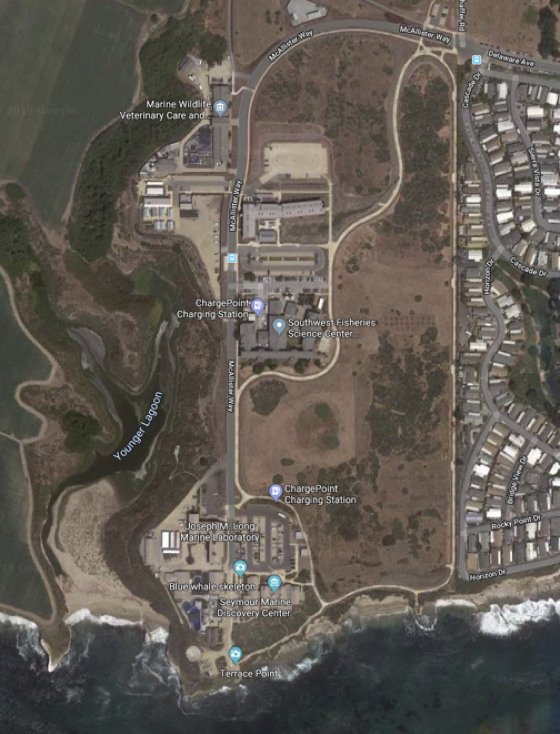
For more information on the Seymour Center, please go to https://seymourcenter.ucsc.edu
Information for Participants
Registration
Registration begins April 29, 2019 and is required for all participants.
To register, please go to SSDBM 2019 Registration.
In order to avoid double charges, please register only ONCE.
Regular registration fees are available through July 6 July 14, 2019. Late registration will start July 7 July 15. You can bring up to three guests to the July 23rd Reception and/or the July 24th Banquet for a fee of $90 per guest.
| Type of Fee | Dates available | Amount |
|---|---|---|
| Regular Registration | April 29 through |
$475.00 |
| Late Registration | $600.00 | |
| Guest fees for Reception and Banquet | April 29 through July 24 | $90.00 (up to 3 guests) |
Registration fees include:
- Participation at all sessions
- Lunches and breaks during the conference
- The Welcome Reception on Tuesday Evening, July 23
- The Conference Banquet on Wednesday evening, July 24
Please note: Daily lunches are for full conference registrants only. If you wish to bring a guest for daily lunch, then they will have to register as a full-price attendee, which will give them access to everything, including daily lunches, the Reception and the Banquet.
Support Letters for Visa
If you need a visa support letter for attending the conference, please send an email to Lavinia Preston, lpreston@ucsc.edu and provide the following information:
- Name (as stated on your passport)
- Passport number and country of citizenship
- Residential address
- Date of birth
- Business name and email address
Please note:
- Registration must be completed and paid in full before a Letter of Invitation may be requested.
- A copy of your registration payment receipt must accompany your request.
- The email must be sent from your business email address.
We will send you your visa support letter as a PDF via email.
To find out if you need a visa, please go to https://travel.state.gov/content/travel/en/us-visas.html for general visa application information.
The most common type of visa for conference attendees is the B-1 visa. Go to https://travel.state.gov/content/travel/en/us-visas/business.html for information on how to apply.
Please be aware that this process can take several months, so if you need a U.S. visa you are encouraged to research and/or apply as soon as possible.
Accommodation
SSDBM 2019 discounted room blocks are available at several local hotels for conference attendees (interactive map coming soon).
Attendees need to make reservations directly and will be responsible for their own room, tax and incidental charges.
SSDBM 2019 discount rates are available from July 22 through July 25 (checkout July 26) or a portion thereof. If you wish to arrive before or after those dates, you must make arrangements directly with the hotel.
Please make your reservations early. The special rate cut-off dates range from June 1 to June 22, which is an entire month before the SSDBM Conference. Summer is high season for tourists in Santa Cruz, and your chances of booking a hotel room anywhere after June 20th are very slim, and if you do, it will be much more expensive than the SSDBM 2019 rates.
Individual hotels have different requirements for registration and slightly different registration codes and cut-off dates, so please read the following instructions for each hotel below.
Please note: all rooms in all hotels are non-smoking.
Hotel Paradox
 611 Ocean Street
611 Ocean Street
Santa Cruz, CA 95060
+1-831-600-4510
www.hotelparadox.com
A discount rate of $189/night is available. Cut-off date is June 21, 2019.
To reserve, call +1-844-236-8186 and ask for the “UCSC SSDBM Conference Room Block Discount Rate.”
Or go to: UCSC SSDBM 2019 - Reservation-link
Reservations must be confirmed by or before June 21 to be eligible for the discount. Discount rates are only available for accommodations July 22 through July 26 for a single KING bed-type or a double QUEEN bed-type.
If you experience any technical challenges or wish to book outside the block dates, please contact Collin Cowsill at Hotel Paradox at +1-831-600-4510.
Holiday Inn Express & Suites
 1410 Ocean Street
1410 Ocean Street
Santa Cruz, CA 95060
+1-831-466-9100
www.hiexpress/santacruz
A two-night minimum stay is required. A discount rate of $219/night is available. Cut-off date is June 21, 2019.
To reserve a room, go to: SSDBM Santa Cruz 2019 - Online Booking Link. To show two queen bedded rooms in the search, adjust the date range to July 22 to July 24.
- Parking is $7 plus tax per night.
- Complimentary Express Start Breakfast Bar featuring hot and cold breakfast items including our famous cinnamon rolls and pancake machine.
- Complimentary wireless internet.
Fairfield Inn & Suites by Marriott
 2956 Mission Street
2956 Mission Street
Santa Cruz, CA 95060
+1-831-420-0777
Discount rates are: $199/night for a QUEEN, $209/night for a Double QUEEN (no KING rooms were offered). Cut-off date is June 21, 2019.
To reserve rooms please contact the hotel directly at +1-831-420-0777. Once you reach a reservations agent, inform the agent that you are calling for the SSDBM-UCSC conference. It is also listed as SSDO for the group rate code. Either piece of information will allow the agent to make the reservation.
The Fairfield Inn cannot accommodate group reservations online, but if you are unable to make your reservation by phone, please contact Lavinia at lpreston@ucsc.edu and she will send a credit card form and tell you how to make a reservation via email.
- Free parking.
https://www.marriott.com/hotels/travel/sjccr-fairfield-inn-and-suites-santa-cruz/
Hilton Santa Cruz/Scotts Valley
 6001 La Madrona Drive
6001 La Madrona Drive
Santa Cruz, CA 95060
+1-831-440-1000
A discount rate of $189/night is available. Cut-off date is June 22, 2019.
To reserve rooms by phone, please call +1-831-440-1000 and press the option for reservations. Be sure to mention the Group Code UCSSD.
For online reservations go to www.santacruzscottsvalley.hilton.com
- Enter the dates of your stay (between July 22 & 25 or the discounted rate will not show up).
- Click the “more options” link.
- Click the “Add special rate codes” link.
- Enter UCSSD in the “Group Code” field
- Click the “check availability” button
Please note: the Hilton is about 6.5 miles north of Santa Cruz. However, it is a wonderful hotel situated on Hwy 17, the main route from Santa Cruz to San Jose, and can be very convenient for those who might need to get to the airport quickly. It takes approximately 15 minutes to drive to or from UCSC, depending on the time of day.
- Free self parking.
Hyatt Place
 407 Broadway Ave.
407 Broadway Ave.
Santa Cruz, CA 95060
+1-831-226-2300
www.hyatt.com
Discount rates are: $213/night for a single or double room. $233/night for a triple or quad room. Cut-off date is June 1 June 22, 2019.
To reserve rooms by phone, please call +1-888-492-8847 and use the Group Code G-USOE. If they need more information, tell them you are with SSDBM.
For online booking go to www.hyatt.com and make the reservation as follows:
- Enter Santa Cruz for city and the dates you wish to stay (July 22 through July 26)
- Click Special Rates (AAA, Govt, …)
- Check Corporate or Group Code
- Enter G-USOE, click Return, and you should see the room selections
- You will need to provide a credit card number at the time of booking.
- Valet parking: $15/night
Mission Inn
 2250 Mission Street
2250 Mission Street
Santa Cruz, CA 95060
+1-831-425-5455
https://www.missioninnsantacruz.com/
Discount rates are: $269/night for a QUEEN room, $296/night for a Double QUEEN room, $278/night for a KING room. Cut-off date is June 22, 2019.
To reserve rooms, please call +1-831-425-5455 and use the Group Name SSDBM 2019.
Each room has:
- High speed wifi
- Hair Dryer
- Microwave
- Iron and ironing board
- Refrigerator
- Coffee
- Free, extensive continental breakfast each morning from 7:00-10:00am.
- Free parking.
Conference Venue
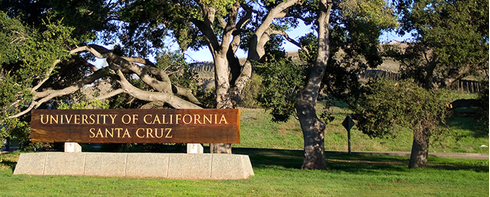
About UC Santa Cruz
Since its founding in 1965, the University of California, Santa Cruz, has earned international distinction as a university with high-impact research and an uncommon commitment to teaching and public service.
A campus with world-class facilities and one of the most visually spectacular settings in higher education, UC Santa Cruz offers rigorous academic programs and cutting-edge research opportunities that teach students how to think, not what to think. Commitments to environmental stewardship and community engagement are central to UCSC’s core values.
From 652 students in 1965, the campus has grown to its current (2017-18) enrollment of more than 18,000 students. Undergraduates pursue bachelor’s degrees in 65 different majors supervised by divisional deans of arts, engineering, humanities, physical & biological sciences, and social sciences.
Graduate students work toward graduate certificates, master’s degrees, or doctoral degrees in 41 academic programs under the supervision of the divisional and graduate deans.
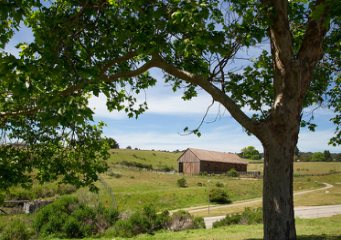
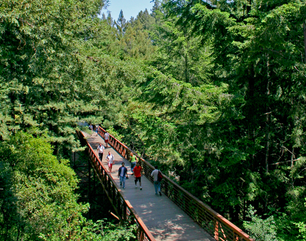
The 10 UC Santa Cruz undergraduate colleges — each a separate community with its own buildings and administration — are built around a core of shared university facilities. These include the main and science/engineering libraries, performing arts buildings, visual arts studios, classrooms, computer facilities, and a complex of highly specialized buildings for the physical and biological sciences, and for engineering. Athletic facilities are provided on the east and west sides of the campus.
UC Santa Cruz is increasing both its enrollment and resources and diversifying its educational and research opportunities. New academic programs are considered and added when desirable and feasible. The campus’s physical growth is guided by its most recent Long-Range Development Plan which is being updated. In 2013-14 the campus initiated a strategic planning process to identify priorities and published its final report in March 2017.
A number of state-of-the-art buildings have been completed on campus in recent years, including the Biomedical Sciences Building, the Humanities and Social Sciences Facility, the Digital Arts Research Center, and the McHenry Library expansion. A restored and updated Quarry Amphitheater reopened in fall 2017.
UC Santa Cruz continues to move forward with its Silicon Valley Campus, a multi-disciplinary teaching and research hub that is home to a master’s degree program in games and playable media, engineering faculty, the new office of industry alliances and technology commercialization, UCSC Silicon Valley Extension, and UC Scout.
Go to https://www.ucsc.edu/visit/index.html to find out more about visiting UC Santa Cruz.

In addition to the Main Campus, there are several other UCSC places to visit in the Santa Cruz area. A few examples are: the Arboretum, Farm & Garden, and the Coastal Science Campus.
Arboretum
Located on Empire Grade one-half mile west of the main entrance to the campus, the Arboretum has extensive collections of plants from the South Pacific and South Africa, other exotic flora, a rock garden, and a eucalyptus grove. Call 831-502-2998 for more information; 502-2999 for Norrie’s Gift & Garden Shop; or go to the Arboretum web site.
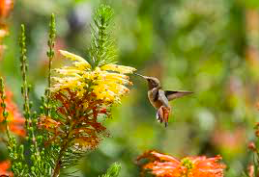
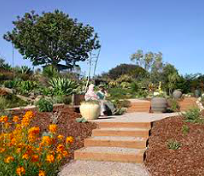
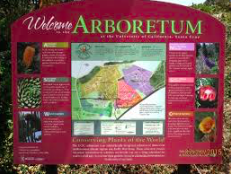
Farm & Garden
The 30-acre organic Farm, where the Center for Agroecology & Sustainable Food Systems does much of its work, is located west of the main entrance road. Fruit trees, vegetables, flowers, herbs, berries, and other research crops are used to study nonchemical, organic methods of sustainable agriculture. Similar work is done at the three-acre Alan Chadwick Garden established in 1967 just below Merrill College. Produce from the Farm is marketed from late spring through early fall. Both facilities are open year-round. Open houses and public talks on techniques for growing plants and trees are also offered. For general information, call 831-459-4140; for group tours, call 831-459-3240.
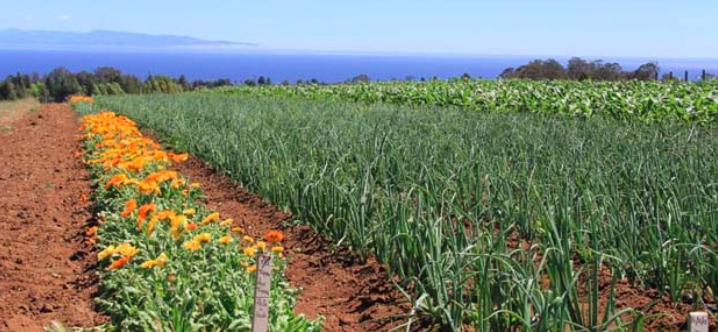

Coastal Science Campus
The approximately 100-acre UC Santa Cruz Coastal Science Campus — at the western end of Delaware Avenue in Santa Cruz — is at the edge of the Pacific Ocean, three miles from the main campus. Facilities include UCSC’s Long Marine Laboratory and its Seymour Marine Discovery Center and Center for Ocean Health; the National Marine Fisheries Service Santa Cruz Laboratory; and a California Department of Fish and Wildlife lab.
The newly constructed Coastal Biology Building is home to UCSC’s department of Ecology and Evolutionary Biology and provides state of the art classroom and lab facilities for undergraduates, graduates, researchers and faculty focused on the study of biology, marine sciences, ecology and evolution, and plant sciences.
The Seymour Marine Discovery Center is open to the public. Visitors may learn about marine life in Monterey Bay and the Pacific through aquaria and other exhibits, including the skeleton of an 87-foot blue whale. Tours offer glimpses of research projects involving bottle-nosed dolphins, California sea lions, sea otters, elephant seals, and harbor seals. For more information, call 831-459-3800 or visit the Seymour Center web site.
The SSDBM Banquet will be held at the Seymour Marine Discovery Center on July 24th. At that time the Exhibit Hall will be open to SSDBM guests exclusively from 5:30-6:30pm. Docents will be available at the Seawater Table to talk about the marine life and the uniqueness of the Monterey Bay.
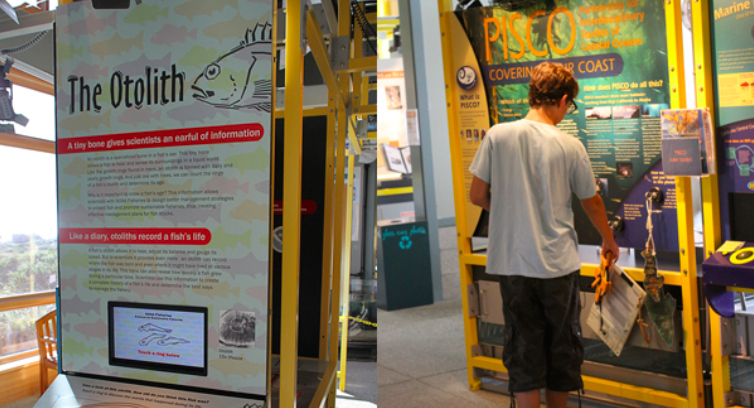
Unlike a traditional aquarium, the Seymour Marine Discovery Center takes you behind the scenes to learn more about scientific research in our oceans. Learn more about elephant seal behavior, understand the role of sea otters in their ecosystem, observe the differences in plant and animal life in different tidepools, or learn more about the hearing of sea lions and harbor seals.
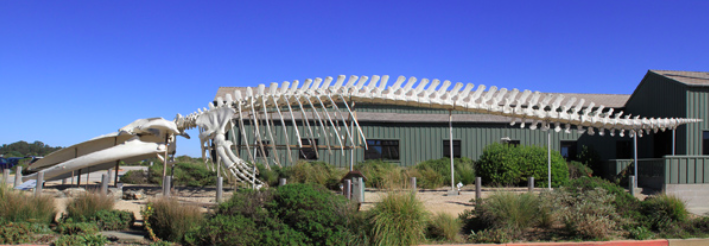
Blue Whale skeleton – this 87-foot blue whale skeleton is one of the largest skeletons of any kind, displayed anywhere in the world. When she died in 1979, she washed ashore north of Santa Cruz near Pescadero, and her skeleton was assembled in 1985. For more, see https://seymourcenter.ucsc.edu/exhibits/outdoor-giants/
Directions: Getting There
We recommend to use the most direct flight to San Jose (SJC, closest), San Francisco (SFO), or Oakland (OAK) International Airports and then rent a car to get to Santa Cruz. Google Maps does a reasonable job finding the fastest route to Santa Cruz. However, the best routes and driving times can vary significantly depending on day of week and time of day. So when you plan your trip in advance, we recommend the desktop web browser version of Google Maps to get access to its “Depart at” and “Arrive by” functionality. Also, during your trip watch for new route recommendations due to accidents to avoid significant traffic delays.
NOTE ON SUMMER TRAFFIC: On the weekends, Santa Cruz is a major destination for travelers from the San Francisco Bay Area, and traffic on Highway 17 that travels through the Santa Cruz Mountains from San Jose to Santa Cruz can be extremely congested. If you are driving and arrive on a weekend, please be aware that until about 1:00 or 2:00pm each day, it could take over 2 hours to reach Santa Cruz from San Jose.
Getting Around
Traffic is also heavy in Santa Cruz itself. Your hotel concierge should be able to suggests good ways to get around town without having to drive and park.
Bicycling
If you are comfortable bicycling, look for bright red Jump bicycles that come with battery assist, especially helpful when heading the long uphill from downtown to campus. We strongly recommend bringing a bicycle helmet if you plan to use this mode of transportation.
Carpooling
We strongly urge those of you who are driving to consider carpooling with other attendees. Traffic, even in summer, can be heavy on campus and it might be easier and simpler to carpool wherever possible.
With that in mind we have set up a Google sheet where you can sign up to offer a ride or request a ride.
If you are looking for riders, enter your information for each day in the green “Looking for Riders” sections on the list. If you are looking for a driver, then enter your information for each day in the blue “Looking for Drivers” sections on the list.
Uber & Lyft
Alternatively, using Uber or Lyft is another way to get to campus without having to drive yourself.
Santa Cruz Metro Transit
The local public transportation system is also a fine way to get around and has regularly scheduled buses with multiple stops on UC Santa Cruz campus, including “Science Hill (UCSC)” which is where the conference takes place. It costs $2 cash (need to have exact amount) for one ride. You can also order and buy passes online (Fares, Map, Schedule).
UCSC Shuttles
In addition to the Santa Cruz Metro buses, UCSC runs campus shuttle buses. The shuttles (aka “UCSC Loop Bus”) are free and useful for getting around within campus (Map and Schedule). The bus stop closest to the conference is “Science Hill (UCSC)”, the one closest to Physical Sciences and Jack Baskin Engineering buildings near the upper left of the map. Buses operate in both directions and both directions are about the same distance from the campus main entrance.
Conference Parking
Should you choose to drive to campus, Google Maps driving directions are available for “UCSC Core West Structure”. Also, starting at the campus main entrance there will be small black & white signs that say “SSDBM” to help guide you to Core West parking.
Parking permits are required for parking (you will get a ticket if you do not display one).
Parking permits can be picked up at the Core West parking structure each morning of the conference between 7:30 and 9:30am. Event parking attendants will meet you on the second floor of the garage; keep driving until you see them. Attendants will have a list of registered attendees, so be prepared to identify yourself as an SSDBM participant. They will give you a permit to display on your car dashboard and direct you to a parking space. See map below for details about how to get to Core West parking as well as where to park for the Hay Barn reception on July 23.
IMPORTANT: The parking attendants leave the garage promptly at 9:30 am. If you need a parking permit, but arrive after 9:30am or you did not request one when you confirmed your attendance (and therefore are not on the parking attendant’s list of registered attendees), then instead of entering the Core West structure, drive to the Baskin Circle (see map below). Follow the road around to the curb area, park in the green loading zone and call or text Lavinia at +1-408-505-4729. DO NOT LEAVE YOUR CAR. If there is no space to park, just keep circling or pull over out the way somewhere. Lavinia will quickly send someone to you with a permit, after which you can retrace your steps and park in Core West.
After you park, proceed to the North Stairwell and walk across the street to the Baskin Engineering Building. Walk through the Baskin Engineering Building and to the courtyard behind it. The check-in desk will be set up next to a big tent.
Conference Venue
The SSDBM 2019 Conference will take place at the Baskin School of Engineering, University of California, Santa Cruz, 1156 High Street, Santa Cruz, CA.
The conference will be held in Room 180, on the ground floor of the Engineering 2 building, which is located off the Courtyard Area between Engineering 2 and the Baskin Engineering Building (see map below). We will have a tent and check-in desk set up outside the room.
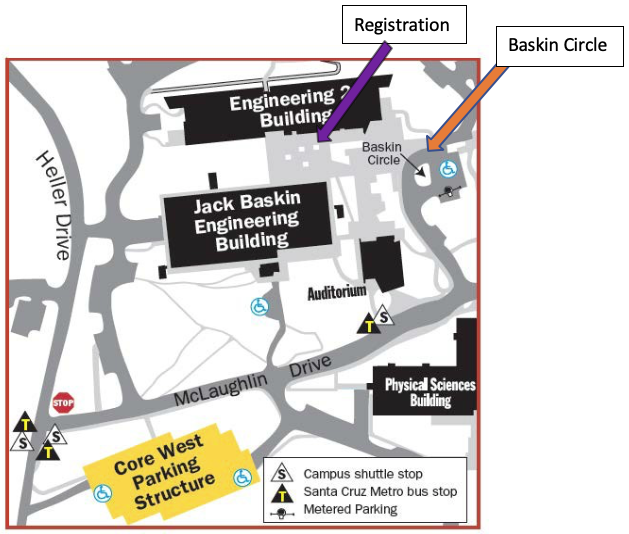
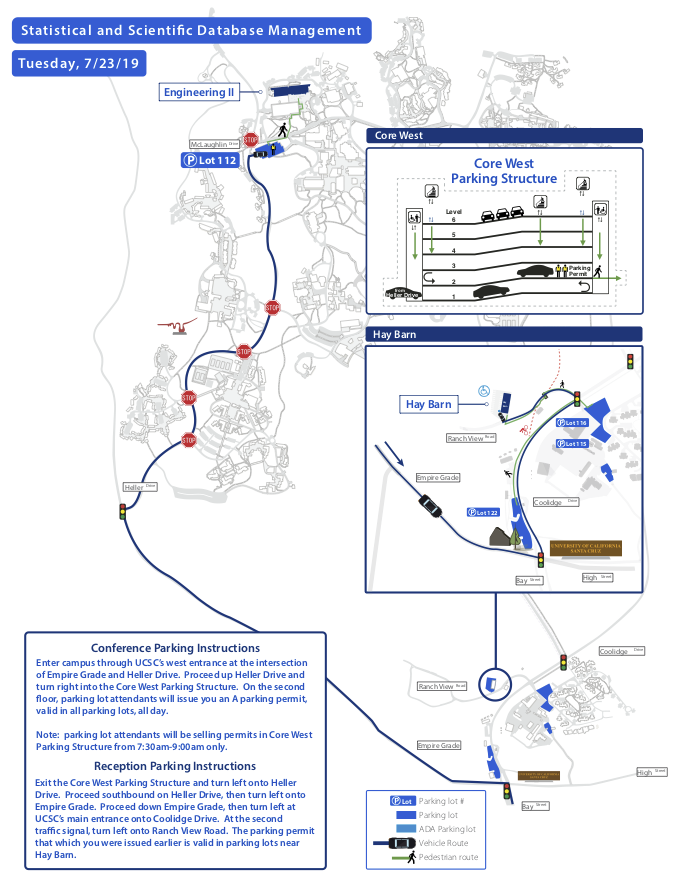
About Santa Cruz
History
In 1769 the Spanish explorer Don Gaspar de Portola discovered the land area which is now known as the City of Santa Cruz. When he came upon the beautiful flowing river, he named it San Lorenzo in honor of Saint Lawrence. He called the rolling hills above the river Santa Cruz, which means holy cross.
Twenty-two years later, in 1791, Father Fermin de Lasuen established a mission at Santa Cruz, the twelfth mission to be founded in California. Across the San Lorenzo River, in what is now known as East Santa Cruz, Villa de Branciforte was established It was founded by the Spanish as one of three civil settlements or pueblos in California. The other pueblos were San Jose and Los Angeles. Villa de Branciforte later merged with the Mission Santa Cruz community across the river.
By the 1820’s Mexico had assumed control of the area and within the next twenty years, Americans began to arrive in great numbers. California became a state in 1850 and Santa Cruz County was created as one of the twenty-seven original counties.
By the turn of the century logging, lime processing, agriculture, and commercial fishing industries prospered in the area. 
 Due to its mild climate and scenic beauty Santa Cruz also became a prominent resort community.
Due to its mild climate and scenic beauty Santa Cruz also became a prominent resort community.
Santa Cruz was incorporated in 1866 as a town under the laws of the State of California and received its first charter as a city in 1876. [More Santa Cruz History…]
Downtown Santa Cruz
Santa Cruz is a bustling small city of about 65,000 people located at the northern end of Monterey Bay. It is about 32 mi (51 km) south of San Jose and 75 mi (120 km) south of San Francisco.
Santa Cruz is known for its moderate climate, natural environment, coastline, redwood forests, alternative community lifestyles, and socially liberal leanings. It is also home to the University of California, Santa Cruz, a premier research institution and educational hub, as well as the Santa Cruz Beach Boardwalk, an oceanfront amusement park operating continuously since 1907.
Pacific Avenue is the main downtown street, and it’s loaded with shops, restaurants and great movie theaters. See http://www.downtownsantacruz.com/about/ for details about some of the shops, restaurants and sights.
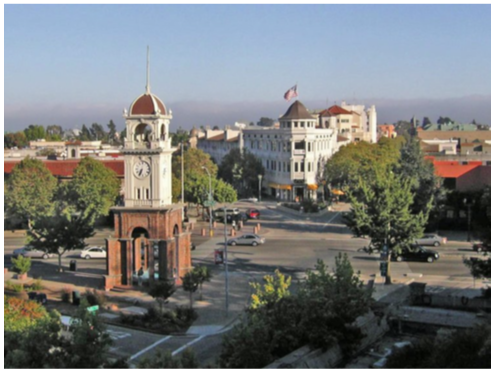
Santa Cruz Beach Boardwalk
The Santa Cruz Beach Boardwalk is a classic seaside amusement park located along a beautiful sandy beach. The Boardwalk features more than 40 rides and attractions including two National Historic Landmarks: the world- famous 1924 Giant Dipper wooden roller coaster and the beautiful 1911 Looff Carousel, plus many scream- inducing thrill rides, gentle kiddie rides, casual restaurants, gift shops, games, indoor arcades, and miniature golf. See https://beachboardwalk.com/FAQs for details about visiting this iconic amusement area.
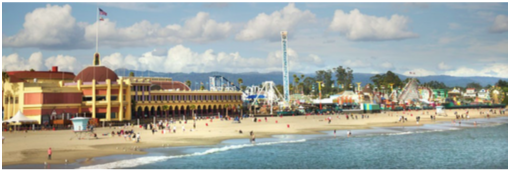
Natural Bridges State Beach
Natural Bridges State Beach is a 65-acre California state park in Santa Cruz, California in the United States. The park features a natural bridge across a section of the beach. It is also well known as a hotspot to see monarch butterfly migrations. Their website provides details on visiting.
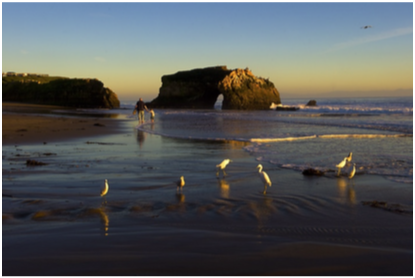
Santa Cruz Wharf
The Santa Cruz Wharf is known for fishing, boat tours, viewing sea lions, dining, nightlife and gift shops. The current wharf was built in 1914, the last of six built on the site, and is operated by the City of Santa Cruz Parks and Recreation Office. Details are available on their website.
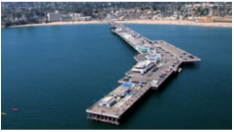
Santa Cruz Surfing Museum
The Santa Cruz Surfing Museum is a museum which was established in May 1986 to document the history of surfing. With collections dating back to the earliest years of surfing on mainland United States, the museum houses a historical account of surfing in Santa Cruz. It is located on West Cliff Drive on the cliff above the well-known surfing spot, Steamer Lane.
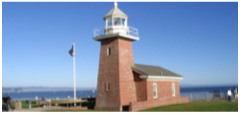
Steamer Lane
Steamer Lane is a famous surfing location in Santa Cruz just below the Santa Cruz Surfing Museum. There are paths and walkways on top of the cliff that provide great views of the waves and the surfers.
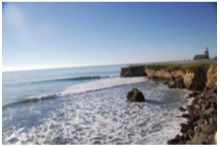
West Cliff Drive Scenic Walk
West Cliff Drive is a scenic, 3-mile walking and biking path along the Pacific Ocean in Santa Cruz. Watch surfers, observe wildlife or just admire the incredible ocean views.
Start your walk at the Santa Cruz Municipal Wharf and head past the iconic Santa Cruz Dream Inn to watch some of the best surfers in the world catch a wave at world-renown Steamer Lane. Stop in for a little surfing history at the Santa Cruz Surfing Museum or watch for whales and dolphins at Lighthouse Point. West Cliff Drive ends at Natural Bridges State Beach, winter home of the Monarch butterfly. Turn around and head back, for a hike that covers almost 6 miles round-trip. West Cliff Drive is wheelchair accessible and is popular with locals and tourists alike.
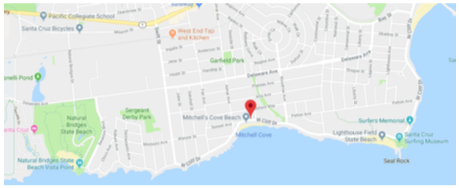
For a comprehensive list of things to see and do in Santa Cruz go to https://www.santacruz.org/things-to-do
The Santa Cruz Area
The area around Santa Cruz is loaded with beaches, parks and things to do, including redwood forests such as Big Basin and Henry Cowell State Parks.
In addition to the beaches in Santa Cruz itself there are numerous other city and state beaches both north and south of Santa Cruz, each one unique in its own way.
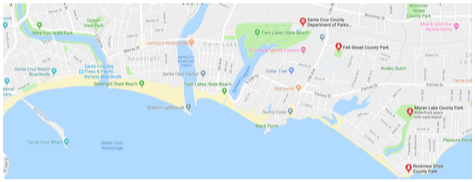
Santa Cruz Area Restaurants
Downtown & Beach Area
515 Kitchen & Cocktails –California Cuisine
Alderwood – Seasonal Local Cuisine
Gabriella Café – Local Cuisine
Laili - Mediterranean/Afghan Cuisine
El Palomar – Mexican Cuisine
Oswald – California Cuisine
Sawasdee – Thai Cuisine overlooking Wharf
Olita’s – Mexican restaurant on the Wharf
Woodstock’s Pizza – Pizza and salads
West Santa Cruz (closest to UC Santa Cruz)
Sabieng - Thai Cuisine
West End Tap – Pub and California Cuisine
Burger Santa Cruz – Burgers/pizza
Bantam – Wood-fired Pizza
Seabright/Midtown Area (East Santa Cruz)
Akira Santa Cruz – Sushi
Jaguar – Provincial Mexican Cuisine
Capitola/Aptos/Soquel Area
These restaurants are further away (15-30 minutes), but are highly recommended.
Café Cruz - 2621 41st Ave., Soquel – California Cuisine
Persephone – 7945 Soquel Drive, Aptos – Seasonal Fine Dining
Gayle’s Bakery and Rosticceria – 504 Bay Avenue, Capitola – Bakery and Deli/hot foods to go
Shadowbrook Restaurant – Traditional Dinner House overlooking river in Capitola (Note: they have a dining room dress code)
Scotts Valley (Mt. Herman Road exit off Hwy 17 before you get to Santa Cruz)
Ambrosia India Bistro – Indian Cuisine
Sushi Blossom – Sushi
Malone’s – steaks, burgers
Sponsorship
Call for Sponsors
We are seeking the sponsorship of companies for the 31st International Conference on Scientific and Statistical Database Management (SSDBM 2019) to be held at the University of California, Santa Cruz, USA.
The SSDBM international conference brings together scientific domain experts, database researchers, practitioners, and developers for the presentation and exchange of current research results on concepts, tools, and techniques for scientific and statistical database applications. The 31st SSDBM will provide a forum for original research contributions and practical system design, implementation and evaluation, and, for the first time, reproducibility studies of previous publications. The program of the research track will be supplemented with invited talks and demonstrations. SSDBM 2019 will continue the tradition of past SSDBM meetings in providing a stimulating environment to encourage discussion, fellowship and exchange of ideas in all aspects of research related to scientific and statistical data management.
In order to keep registration fees low and attract especially students and young researchers, we would appreciate the financial support of companies and foundations. Sponsors for recent SSDBM conferences include Teradata, SDSC, NSF, Ericsson, and Rasdaman.
We offer the following sponsorship packages:
Bronze Sponsor ($700)
- Logo/name as bronze sponsor in all publications and the website
Silver Sponsor ($1,200)
- Logo/name as silver sponsor in all publications and the website
- Free registration for 1 participant
Gold Sponsor ($2,500)
- Logo/name as gold sponsor in all publications and the website
- Banner at the conference location, banquet and reception
- Flyers/giveaways in handout bags
- Free registration for 2 participants
Platinum Sponsor ($5,000+)
- Logo/name as platinum sponsor in all publications and the website
- Banner at the conference location, banquet and reception
- Flyers/giveaways in handout bags
- Free registration for 4 participants
For sponsorship, please contact:
Stephanie Lieggi
University of California, Santa Cruz
E-mail: slieggi@ucsc.edu
Phone: +1-831-459-1932


